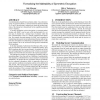Free Online Productivity Tools
i2Speak
i2Symbol
i2OCR
iTex2Img
iWeb2Print
iWeb2Shot
i2Type
iPdf2Split
iPdf2Merge
i2Bopomofo
i2Arabic
i2Style
i2Image
i2PDF
iLatex2Rtf
Sci2ools
CCS
2010
ACM
2010
ACM
On the soundness of authenticate-then-encrypt: formalizing the malleability of symmetric encryption
A communication channel from an honest sender A to an honest receiver B can be described as a system with three interfaces labeled A, B, and E (the adversary), respectively, where the security properties of the channel are characterized by the capabilities provided at the E-interface. A security mechanism, such as encryption or a message authentication code (MAC), can be seen as the transformation of a certain type of channel into a stronger type of channel, where the term "transformation" refers to a natural simulation-based definition. For example, the main purpose of a MAC can be regarded as transforming an insecure into an authenticated channel, and encryption then corresponds to transforming an authenticated into a fully secure channel; this is the well-known Encrypt-then-Authenticate (EtA) paradigm. In the dual paradigm, Authenticate-then-Encrypt (AtE), encryption first transforms an insecure into a confidential channel, and a MAC transforms this into a secure channel....
CCS 2010 | Encryption | Secure Channel | Security | Security Privacy |
| Added | 06 Dec 2010 |
| Updated | 06 Dec 2010 |
| Type | Conference |
| Year | 2010 |
| Where | CCS |
| Authors | Ueli Maurer, Björn Tackmann |
Comments (0)

